[English] 日本語
 Yorodumi
Yorodumi- PDB-3sko: Crystal structure of the HLA-B8-A66-FLR, mutant A66 of the HLA B8 -
+ Open data
Open data
- Basic information
Basic information
| Entry | Database: PDB / ID: 3sko | ||||||
|---|---|---|---|---|---|---|---|
| Title | Crystal structure of the HLA-B8-A66-FLR, mutant A66 of the HLA B8 | ||||||
 Components Components |
| ||||||
 Keywords Keywords | IMMUNE SYSTEM / T cell receptor / antigen presentation | ||||||
| Function / homology |  Function and homology information Function and homology informationhost cell nuclear matrix / regulation of interleukin-12 production / regulation of dendritic cell differentiation / regulation of T cell anergy / regulation of interleukin-6 production / TAP binding / protection from natural killer cell mediated cytotoxicity / viral process / antigen processing and presentation of endogenous peptide antigen via MHC class Ib / antigen processing and presentation of endogenous peptide antigen via MHC class I via ER pathway, TAP-independent ...host cell nuclear matrix / regulation of interleukin-12 production / regulation of dendritic cell differentiation / regulation of T cell anergy / regulation of interleukin-6 production / TAP binding / protection from natural killer cell mediated cytotoxicity / viral process / antigen processing and presentation of endogenous peptide antigen via MHC class Ib / antigen processing and presentation of endogenous peptide antigen via MHC class I via ER pathway, TAP-independent / detection of bacterium / secretory granule membrane / negative regulation of receptor binding / early endosome lumen / Nef mediated downregulation of MHC class I complex cell surface expression / DAP12 interactions / transferrin transport / cellular response to iron ion / Endosomal/Vacuolar pathway / Antigen Presentation: Folding, assembly and peptide loading of class I MHC / peptide antigen assembly with MHC class II protein complex / lumenal side of endoplasmic reticulum membrane / cellular response to iron(III) ion / negative regulation of forebrain neuron differentiation / MHC class II protein complex / antigen processing and presentation of exogenous protein antigen via MHC class Ib, TAP-dependent / ER to Golgi transport vesicle membrane / peptide antigen assembly with MHC class I protein complex / regulation of iron ion transport / regulation of erythrocyte differentiation / defense response / HFE-transferrin receptor complex / response to molecule of bacterial origin / MHC class I peptide loading complex / T cell mediated cytotoxicity / positive regulation of T cell cytokine production / antigen processing and presentation of endogenous peptide antigen via MHC class I / antigen processing and presentation of exogenous peptide antigen via MHC class II / positive regulation of immune response / MHC class I protein complex / peptide antigen binding / positive regulation of T cell activation / negative regulation of neurogenesis / positive regulation of receptor-mediated endocytosis / cellular response to nicotine / positive regulation of T cell mediated cytotoxicity / multicellular organismal-level iron ion homeostasis / specific granule lumen / phagocytic vesicle membrane / recycling endosome membrane / Interferon gamma signaling / Immunoregulatory interactions between a Lymphoid and a non-Lymphoid cell / negative regulation of epithelial cell proliferation / MHC class II protein complex binding / Interferon alpha/beta signaling / Modulation by Mtb of host immune system / late endosome membrane / sensory perception of smell / positive regulation of cellular senescence / tertiary granule lumen / DAP12 signaling / T cell differentiation in thymus / negative regulation of neuron projection development / protein-folding chaperone binding / ER-Phagosome pathway / protein refolding / early endosome membrane / protein homotetramerization / amyloid fibril formation / adaptive immune response / intracellular iron ion homeostasis / learning or memory / immune response / endoplasmic reticulum lumen / Amyloid fiber formation / Golgi membrane / signaling receptor binding / innate immune response / lysosomal membrane / external side of plasma membrane / focal adhesion / Neutrophil degranulation / SARS-CoV-2 activates/modulates innate and adaptive immune responses / structural molecule activity / cell surface / endoplasmic reticulum / Golgi apparatus / protein homodimerization activity / extracellular space / extracellular exosome / extracellular region / identical protein binding / membrane / plasma membrane / cytosol Similarity search - Function | ||||||
| Biological species |  Homo sapiens (human) Homo sapiens (human) Human herpesvirus 4 (Epstein-Barr virus) Human herpesvirus 4 (Epstein-Barr virus) | ||||||
| Method |  X-RAY DIFFRACTION / X-RAY DIFFRACTION /  SYNCHROTRON / SYNCHROTRON /  MOLECULAR REPLACEMENT / MOLECULAR REPLACEMENT /  molecular replacement / Resolution: 1.6 Å molecular replacement / Resolution: 1.6 Å | ||||||
 Authors Authors | Gras, S. / Wilmann, P.G. / Zhenjun, C. / Hanim, H. / Yu Chih, L. / Kjer-Nielsen, L. / Purcell, A.W. / Burrows, S.R. / Mccluskey, J. / Rossjohn, J. | ||||||
 Citation Citation |  Journal: J.Immunol. / Year: 2012 Journal: J.Immunol. / Year: 2012Title: A structural basis for varied alpha-beta TCR usage against an immunodominant EBV antigen restricted to a HLA-B8 molecule. Authors: Gras, S. / Wilmann, P.G. / Chen, Z. / Halim, H. / Liu, Y.C. / Kjer-Nielsen, L. / Purcell, A.W. / Burrows, S.R. / McCluskey, J. / Rossjohn, J. | ||||||
| History |
|
- Structure visualization
Structure visualization
| Structure viewer | Molecule:  Molmil Molmil Jmol/JSmol Jmol/JSmol |
|---|
- Downloads & links
Downloads & links
- Download
Download
| PDBx/mmCIF format |  3sko.cif.gz 3sko.cif.gz | 106.1 KB | Display |  PDBx/mmCIF format PDBx/mmCIF format |
|---|---|---|---|---|
| PDB format |  pdb3sko.ent.gz pdb3sko.ent.gz | 79.5 KB | Display |  PDB format PDB format |
| PDBx/mmJSON format |  3sko.json.gz 3sko.json.gz | Tree view |  PDBx/mmJSON format PDBx/mmJSON format | |
| Others |  Other downloads Other downloads |
-Validation report
| Summary document |  3sko_validation.pdf.gz 3sko_validation.pdf.gz | 441.3 KB | Display |  wwPDB validaton report wwPDB validaton report |
|---|---|---|---|---|
| Full document |  3sko_full_validation.pdf.gz 3sko_full_validation.pdf.gz | 446.3 KB | Display | |
| Data in XML |  3sko_validation.xml.gz 3sko_validation.xml.gz | 20.8 KB | Display | |
| Data in CIF |  3sko_validation.cif.gz 3sko_validation.cif.gz | 30.7 KB | Display | |
| Arichive directory |  https://data.pdbj.org/pub/pdb/validation_reports/sk/3sko https://data.pdbj.org/pub/pdb/validation_reports/sk/3sko ftp://data.pdbj.org/pub/pdb/validation_reports/sk/3sko ftp://data.pdbj.org/pub/pdb/validation_reports/sk/3sko | HTTPS FTP |
-Related structure data
| Related structure data |  3sjvC 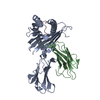 3skmC 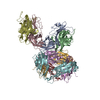 3sknC 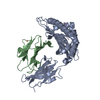 1m05S S: Starting model for refinement C: citing same article ( |
|---|---|
| Similar structure data |
- Links
Links
- Assembly
Assembly
| Deposited unit | 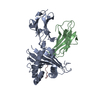
| ||||||||
|---|---|---|---|---|---|---|---|---|---|
| 1 |
| ||||||||
| Unit cell |
| ||||||||
| Details | biological unit is the same as asym. |
- Components
Components
| #1: Protein | Mass: 31972.973 Da / Num. of mol.: 1 / Fragment: Extracellular domain residues 25-301 / Mutation: I66A Source method: isolated from a genetically manipulated source Details: HLA-B8 mutated I66A / Source: (gene. exp.)  Homo sapiens (human) / Gene: HLA-B, HLAB / Plasmid: pET / Production host: Homo sapiens (human) / Gene: HLA-B, HLAB / Plasmid: pET / Production host:  |
|---|---|
| #2: Protein | Mass: 11879.356 Da / Num. of mol.: 1 Source method: isolated from a genetically manipulated source Source: (gene. exp.)  Homo sapiens (human) / Gene: B2M, CDABP0092, HDCMA22P / Plasmid: pET / Production host: Homo sapiens (human) / Gene: B2M, CDABP0092, HDCMA22P / Plasmid: pET / Production host:  |
| #3: Protein/peptide | Mass: 1054.247 Da / Num. of mol.: 1 / Fragment: sequence database residues 325-333 / Source method: obtained synthetically / Source: (synth.)  Human herpesvirus 4 (Epstein-Barr virus) / References: UniProt: Q3KST2 Human herpesvirus 4 (Epstein-Barr virus) / References: UniProt: Q3KST2 |
| #4: Chemical | ChemComp-NA / |
| #5: Water | ChemComp-HOH / |
| Has protein modification | Y |
-Experimental details
-Experiment
| Experiment | Method:  X-RAY DIFFRACTION / Number of used crystals: 1 X-RAY DIFFRACTION / Number of used crystals: 1 |
|---|
- Sample preparation
Sample preparation
| Crystal | Density Matthews: 2.57 Å3/Da / Density % sol: 52.1 % |
|---|---|
| Crystal grow | Temperature: 277 K / Method: vapor diffusion, hanging drop / pH: 5.6 Details: 0.2M ammonium acetate, 20% PEG 4000, 0.1M tri-Na citrate, pH 5.6, vapor diffusion, hanging drop, temperature 277K |
-Data collection
| Diffraction | Mean temperature: 100 K | ||||||||||||||||||||||||||||||||||||||||||||||||||||||||||||||||||||||||||||||||||||
|---|---|---|---|---|---|---|---|---|---|---|---|---|---|---|---|---|---|---|---|---|---|---|---|---|---|---|---|---|---|---|---|---|---|---|---|---|---|---|---|---|---|---|---|---|---|---|---|---|---|---|---|---|---|---|---|---|---|---|---|---|---|---|---|---|---|---|---|---|---|---|---|---|---|---|---|---|---|---|---|---|---|---|---|---|---|
| Diffraction source | Source:  SYNCHROTRON / Site: SYNCHROTRON / Site:  Australian Synchrotron Australian Synchrotron  / Beamline: MX2 / Wavelength: 0.954 Å / Beamline: MX2 / Wavelength: 0.954 Å | ||||||||||||||||||||||||||||||||||||||||||||||||||||||||||||||||||||||||||||||||||||
| Detector | Type: ADSC QUANTUM 315r / Detector: CCD / Date: Mar 11, 2011 | ||||||||||||||||||||||||||||||||||||||||||||||||||||||||||||||||||||||||||||||||||||
| Radiation | Protocol: SINGLE WAVELENGTH / Monochromatic (M) / Laue (L): M / Scattering type: x-ray | ||||||||||||||||||||||||||||||||||||||||||||||||||||||||||||||||||||||||||||||||||||
| Radiation wavelength | Wavelength: 0.954 Å / Relative weight: 1 | ||||||||||||||||||||||||||||||||||||||||||||||||||||||||||||||||||||||||||||||||||||
| Reflection | Resolution: 1.6→100 Å / Num. obs: 61305 / % possible obs: 99.2 % / Observed criterion σ(I): -3 / Biso Wilson estimate: 26.033 Å2 / Rmerge(I) obs: 0.065 / Net I/σ(I): 14.14 | ||||||||||||||||||||||||||||||||||||||||||||||||||||||||||||||||||||||||||||||||||||
| Reflection shell |
|
-Phasing
| Phasing | Method:  molecular replacement molecular replacement |
|---|
- Processing
Processing
| Software |
| |||||||||||||||||||||||||||||||||||||||||||||||||||||||||||||||||||||||||||||
|---|---|---|---|---|---|---|---|---|---|---|---|---|---|---|---|---|---|---|---|---|---|---|---|---|---|---|---|---|---|---|---|---|---|---|---|---|---|---|---|---|---|---|---|---|---|---|---|---|---|---|---|---|---|---|---|---|---|---|---|---|---|---|---|---|---|---|---|---|---|---|---|---|---|---|---|---|---|---|
| Refinement | Method to determine structure:  MOLECULAR REPLACEMENT MOLECULAR REPLACEMENTStarting model: 1m05 Resolution: 1.6→19.708 Å / Occupancy max: 1 / Occupancy min: 0.09 / FOM work R set: 0.8312 / SU ML: 0.21 / σ(F): 0.01 / Phase error: 23.85 / Stereochemistry target values: ML
| |||||||||||||||||||||||||||||||||||||||||||||||||||||||||||||||||||||||||||||
| Solvent computation | Shrinkage radii: 0.9 Å / VDW probe radii: 1.11 Å / Solvent model: FLAT BULK SOLVENT MODEL / Bsol: 34.157 Å2 / ksol: 0.358 e/Å3 | |||||||||||||||||||||||||||||||||||||||||||||||||||||||||||||||||||||||||||||
| Displacement parameters | Biso max: 101.04 Å2 / Biso mean: 24.0325 Å2 / Biso min: 7.76 Å2
| |||||||||||||||||||||||||||||||||||||||||||||||||||||||||||||||||||||||||||||
| Refinement step | Cycle: LAST / Resolution: 1.6→19.708 Å
| |||||||||||||||||||||||||||||||||||||||||||||||||||||||||||||||||||||||||||||
| Refine LS restraints |
| |||||||||||||||||||||||||||||||||||||||||||||||||||||||||||||||||||||||||||||
| LS refinement shell | Refine-ID: X-RAY DIFFRACTION / Total num. of bins used: 10
|
 Movie
Movie Controller
Controller



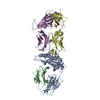

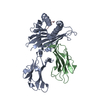

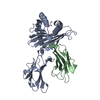
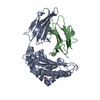
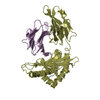
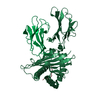




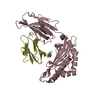
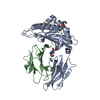
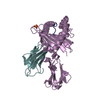



 PDBj
PDBj




